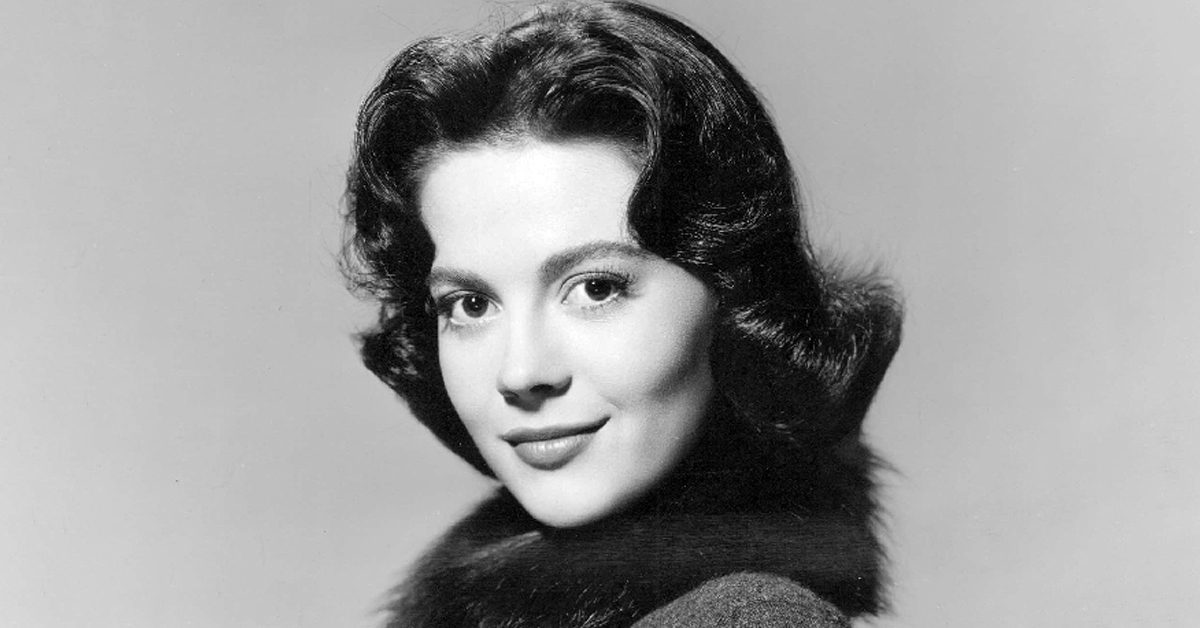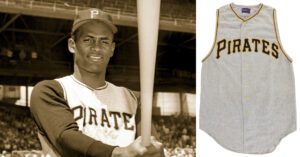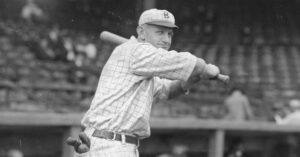During 1947, according to the annual poll, Bing Crosby and Betty Grable were the top two attractions in films. Movie tickets cost forty cents that year. IT’S A WONDERFUL LIFE had just failed at the box-office. Arnold Schwarzenegger and Billy Crystal were born in 1947. Ernst Lubitsch died. Ronald Reagan became president of the Screen Actors Guild. Marilyn Monroe filmed her first movie scene — walking behind child actress Natalie Wood — in Twentieth Century-Fox’s SCUDDA-HOO! SCUDDA-HAY! Later that year, the same studio would drop its option on Monroe….Today, along with Fox studio boss Darryl F. Zanuck, Monroe and Wood are both buried nearby in tiny Westwood Memorial Park.
Once upon a time, in the year of 1944, the days rolled around to Christmas Eve. A 39 year-old writer named Valentine Davies was shopping for his wife’s Christmas present. Davies was from New York, but the crowded stores he fought his way into that particular afternoon were located in Los Angeles. Even there, even then, the commercialism was so oppressive that it struck Davies to wonder, what would the real Santa Claus think, were he to show up that day, and witness what has happened to Christmas? What, indeed.
Davies, who would later write and direct THE BENNY GOODMAN STORY in 1955, decided to compose a story based on this premise. He shared the result with his friend, George Seaton, six years younger, and a fellow screenwriter and director. Seaton would win an Oscar for his script on THE COUNTRY GIRL, also in 1955.
Beginning on a vacation they took with their wives, together Valentine and Seaton spent one year developing a screenplay. In July of 1946, Twentieth Century-Fox purchased screen rights to their property. It bore several working titles as the production evolved: IT’S ONLY HUMAN, THE BIG HEART, MY HEART TELLS ME, MR. KRINGLE, and THE MIRACLE ON HERALD SQUARE. Usually so many titles and differing incarnations spell movie-making trouble. Not this time.
On November 6, 1946, Darryl Zanuck passed his opinion on casting, and the screenplay. “It is excellent, fresh, exciting, and delightful,” the studio chieftain wrote in a memo. “I definitely want to use John Payne. (Contract player) Mark Stevens does not fit the part at all and in any event it is essential that we have a box-office name with (Maureen) O’Hara, as the only conceivable excuse we have for making the picture from a box-office standpoint is the combination of O’Hara and Payne who have already established themselves.”
The 5’8” fiery red-headed 26 year-old beauty, Maureen O’Hara, had already appeared with John Payne in TO THE SHORES OF TRIPOLI (1942), and SENTIMENTAL JOURNEY (1946). General purpose leading man Payne was 34 and then married to Gloria DeHaven. He was a decade away from starring on television in THE RESTLESS GUN.
Zanuck did express two criticisms in his memo. The O’Hara role was written so cold, he thought, that audiences would be hard pressed to forgive her, and like her. (Back then filmmakers held a foolish notion it made sense to give audiences someone to identify with, like and actually pull for when investing an hour or more of one’s life watching a movie.) Zanuck wanted to get across earlier in the story why O’Hara’s character appeared so heartless. He concluded, “Any man who ever heard a mother give her child the kind of advice (O’Hara) does would start running in the other direction….
“I have one other criticism. I believe we go too far with the montage satire dealing with the exploitation of (sending Macy’s customers to Gimbel’s and vice versa)….I believe that we run the risk, for the sake of a few laughs, of jeopardizing the sincerity and honesty of the balance of the story. The very fact that you show the merchants urging courtesies is enough and very amusing but when you go into radio, moving pictures, etc., then I know this has not occurred and I begin to face everything from then on with my tongue in my cheek.
“This story to me is very honest and believable and with the exception of the two above points I like it immensely. I want to believe the story. Don’t do anything that will make me lose faith in it or imagine it is a satire….
“I am crazy about the title THE BIG HEART.” But not for long.
John Payne said he was on suspension at the time for having refused to accept his previous Fox assignment. He was actively looking for something to do in order to get back to work. He asked directors around the lot about their projects and found out about the part in MIRACLE from George Seaton. Payne volunteered to play the attorney after reading the script.
Maureen O’Hara was back in Dublin, visiting her clan, when Zanuck himself phoned. She was to return and report for location shooting in New York, on this project which was completely unknown to her, and immediately. “I was absolutely furious, mad as hell,” O’Hara remembered. “But when I got to New York, and read the script, I knew right away, here was a wonderful, sentimental, warm, gorgeous story. I wasn’t so mad after all.”
To play the somewhat pixillated Kris Kringle, Fox assigned a veteran English character actor, of both stage and screen, named Edmund Gwenn (1875-1959). He must have been an enormous favorite of Johnny Carson, who regularly and fondly mentioned his name, and sometimes this role, on THE TONIGHT SHOW spanning four decades. Gwenn was also known to be a personal favorite of George Bernard Shaw. Though usually a benevolent type, flashing that twinkle in his eye, Gwenn essayed a rare villainous role, for his countryman Alfred Hitchcock, in FOREIGN CORRESPONDENT (1940). Gwenn was appearing on screen well into his eighties.
Maureen O’Hara recalled, “Edmund Gwenn was Santa Claus. I mean that literally. He believed he was Santa Claus.”
Irving Pichel, the villain in GENERAL SPANKY (1936), and co-director on THE MOST DANGEROUS GAME (1932), discovered Natalie Wood while shooting a picture on location in Santa Rosa. Highly intelligent, Wood was making three pictures during the period MIRACLE was in production. At the same time, her parents had just Anglicized Natalie Wood’s real name, Natasha Gurdin, and also told her to imitate reigning child star Margaret O’Brien while playing the part in MIRACLE.
Confusing? Or, is even any part of that clear? It was Natasha, turned Natalie, who was playing three different characters simultaneously (one with an English accent), while taking orders from three directors, as well as confidential and conflicting sideline instructions from her mother, who told Natalie to mimic and be the waifish Margaret O’Brien playing the part of Maureen O’Hara’s daughter! How hard could that be? Somehow, despite all this, Wood still had plenty of time to cue the other actors when they forgot their lines. So she was amazing.
There is a widespread but mistaken perception that THE MIRACLE ON 34TH STREET was intended as a “B” film, or a small film. In remarks attributed even to Natalie Wood, she said, “I was only eight years old, but I remember very clearly. They had no high hopes for MIRACLE whatsoever. It was just a little extra picture that was sort of done on the sideline at Fox. The studio executives kept telling everyone, ‘Let’s hurry up, we don’t have any money for this picture.’”
The average production cost for Hollywood feature films made during 1947 was $732,000. The approved budget allocated for THE MIRACLE ON 34TH STREET was $1.5 million.
Maureen O’Hara said that shooting the picture was “a remarkable experience. The whole project was charmed from start to finish,” she recalled. “Every day, it was magic. We had a wonderful, happy, magical time making the movie. You can talk to anyone who was there; it was just bliss from beginning to end.”
There was, however, one distinct problem. George Seaton had made a unique arrangement to shoot at and use the valuable brand names of two bitterly competing New York City department stores: R.H. Macy & Co., and Gimbel Brothers. Incredibly, each store had to approve the film’s final cut, and if either one disapproved — either one! — the offended company could force any and all of the movie’s scenes to be cut or re-shot! The nature of such risk was unprecedented.
Another bold gamble for authenticity was Seaton’s decision to film the picture’s opening scenes against the backdrop of the actual annual Macy’s Thanksgiving Day Parade to welcome Santa Claus in New York. This was not only expensive but involved the risks of filming at any live event, with a crowd of unruly people (New Yorkers, no less), in what turned out to be freezing cold weather, none of which was subject to any interests of the Fox project. No room or time for mistakes, or re-takes, because as Maureen O’Hara explained, “They couldn’t stop the parade to accommodate us.” But Seaton, using a cast and crew numbering in excess of one-hundred people, was seeking realism, and he got it.
Shooting commenced in New York City, covering the parade, on November 26, 1946, and concluded on February 22, 1947. Additional scenes were made on February 28 and March 1, with a day’s worth of re-takes filmed March 24.
Besides shooting the parade in mid-town Manhattan, and in and around Macy’s department store itself on 34th and Broadway (Gimbel’s was on 33rd Street), scenes were also filmed in lower Manhattan, at the Supreme Court Building, located exactly seven blocks from what’s now known as “Ground Zero,” the site of the Twin Towers later to be erected there, as The World Trade Center. This same building, filmed inside and outside for MIRACLE, was showered with debris on that less than miraculous date, September 11.
THE MIRACLE ON 34TH STREET finished only slightly over budget, amassing a negative cost of $1,572,000.
While the film worked its way through editing, the company staged a cast and crew “wrap” party. It was there that everyone discovered Natalie Wood really did believe Edmund Gwenn was Santa Claus! Without his hairpiece, and having shaved his beard, and put on his glasses, he dropped all pretense of being Santa Claus, and Natalie Wood was shocked! Her biographer reveals, “In fact Natalie thought Edmund Gwenn was, actually, Santa Claus, during the making of the film! It was iconoclastic for her, she thought he was Santa!”
Maureen O’Hara confirmed the allegation, “Yes,” she said, “Natalie adored (Edmund Gwenn) and really thought he was Santa Claus….We all loved him.”
On April 29 the picture was screened separately for executives of Macy’s, and of Gimbel’s. The filmmakers’ fondest wish came true when neither group voiced a single actionable objection! On the contrary, everyone loved it. The preview audiences went wild as well, and a release date of June 4, 1947 was set.
The perception held by many was that Fox had low expectations for MIRACLE, wrote it off almost immediately, and then threw the film away by releasing it with but a modest ad campaign just as school was letting out for the summer. Why, during the hot summer months, would the kiddie trade be lured into theaters without air-conditioning to watch a movie about Christmas? Fox knew they wouldn’t, and didn’t care. Is what many would have us believe.
John Payne, as one of many, offered a take that played into this line of thinking. “Zanuck never liked the picture and almost passed on it,” Payne said, showing right away he was misinformed. “He didn’t much like fantasies of any kind. And when the picture was finished, he set only one sneak preview — in San Bernardino in July, at that time just a little cow town. But the cards came back 99.99% favorable.
“But Zanuck still didn’t like it and released it at the end of summer, well before Christmas. But MIRACLE just kept marching along like the little drummer.”
Payne got this last part right, if little else. What Zanuck knew was what everyone who fails to pay attention to film history doesn’t know. Virtually every time a Christmas picture has been released near Christmas, to capitalize on the seasonal tie-in, it dies. Then, now, always. All the many versions of A CHRISTMAS CAROL, IT’S A WONDERFUL LIFE, Jean Sheperd’s A CHRISTMAS STORY, even Fox’s own remake of A MIRACLE ON 34TH STREET in 1994 — they were released during the Christmas season and were dead in the ice-water on December 26. They all lost money during the initial theatrical release for the same reason. Most are beloved classics today owing to television repeats at Christmas, but that took years and years to achieve. Television operates differently, and is a completely different kind of market and medium.
Before the June 4 domestic release date, MIRACLE was trade shown for critics on May 1, the day following approval by Macy’s and Gimbel’s. The premiere was staged, on the release date, at the Roxy in New York.
The marketing department at Fox was smart and shrewd in how they sold the picture. The ad campaign concealed the Yuletide story entirely, both in its print advertising accessories and its motion picture trailer used to promote the film in theatres. Lobby cards and posters betrayed no connection with anything even remotely suggesting Christmas! The unconventional trailer showed neither scenes from the film nor its stars! Instead of a campaign defining THE MIRACLE ON 34TH STREET as a Christmas story, thereby limiting its appeal, other values were emphasized, and other tricks were used to arouse favorable curiosity about the film. Fox stars including Rex Harrison and Anne Baxter appeared in the trailer, discussing the film with their supposed studio boss without revealing anything about it.
Right from the start, reviews for THE MIRACLE ON 34TH STREET were ecstatic. Critics loved this imaginative, timeless tale of trust, hope, and faith.
Hailed VARIETY: “Actually, this is the story of Santa Claus on trial…a sleeper with sock family appeal, which will also draw with all-class audiences….picture is Edmund Gwenn’s first to last, his role of Kris Kringle the finest thing he’s ever done. Film is warmly human, with as novel a premise as ever sheened, and box office will benefit from word-of-mouth.”
THE HOLLYWOOD REPORTER predicted THE MIRACLE ON 34TH STREET “may well prove to be one of the sleeper hits of the year. Not many among the large group of Hollywood press who attended an invitational preview knew anything about the story of the picture, for it had been deliberately under publicized. This group awarded MIRACLE a hearty round of applause at its conclusion, an unusual procedure at press showings in a town that makes more movies than it approves.”
Fox representatives witnessing that spectacle — of cynical, hard-bitten FRONT PAGE and HIS GIRL FRIDAY types applauding — must have wondered where they were. And was it really Christmas already, in May?
The FILM DAILY scribe declared, “Christmas will come in June and stay a long holiday while at the nation’s box-office. That it will be most welcome at the time of the doldrums too is not hard to imagine….Audiences will sit fascinated, rock with laughter, roar with delight … and maybe even shed a tear.”
THE NEW YORK TIMES heartily recommended MIRACLE as “the freshest little picture in a long time … a delightful surprise … devoid of mighty stars and presented without the usual red-velvet-carpet ballyhoo.”
Despite its humble origins and unassuming presentation, this delightful, unpretentious fantasy won Oscars for Gwenn (supporting actor), Davies (original story), and Seaton (screenplay). Plus there was a nomination for best picture. GENTLEMAN’S AGREEMENT won.
As the picture played and built throughout the summer, fall and up to Christmas, the worldwide gross grew steadily to a total of $3,546,000 to yield a net profit of $1,627,000. This amounted to a remarkable rate of return on investment in excess of 100%. Banks weren’t paying that kind of interest then, now or ever.
In the cast: Porter Hall as the sour psychiatrist, Thelma Ritter making her screen debut as the dubious shopper, reliable gruff old Bill Frawley as the politician, and the always welcome Jerome Cowan as the D.A. Herbert Heyes played Mr. Gimbel, without objection. As did Harry Antrim as Mr. Macy.
In 1955 Fox adapted the property for television starring Thomas Mitchell, MacDonald Carey, and Teresa Wright. CBS aired another version with Fielder Cook, Jane Alexander and Roddy McDowell in 1973.
Hal Roach Studios was the first company to have computer-colorized feature films for pay-TV in 1985 with WAY OUT WEST, IT’S A WONDERFUL LIFE and TOPPER. But MIRACLE was the first computer-enhanced black and white film to be syndicated on free TV that same year.
Fox offered a big budget theatrical remake adapted by John Hughes in 1994 featuring Richard Attenborough and Elizabeth Perkins. Alvin Greenman, the chubby young Santa Claus aspirant in the original film, landed a cameo in the remake.
“I am happy and proud to say (all the remakes) flopped,” Maureen O’Hara laughed decades later. “The first version is still the best one.”




